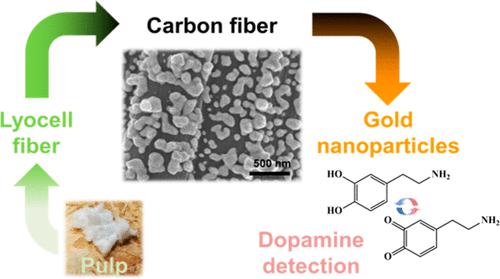当前位置:
X-MOL 学术
›
ACS Sustain. Chem. Eng.
›
论文详情
Our official English website, www.x-mol.net, welcomes your
feedback! (Note: you will need to create a separate account there.)
Gold Nanoparticle/Carbon Fiber Hybrid Structure from the Eco-Friendly and Energy-Efficient Process for Electrochemical Biosensing
ACS Sustainable Chemistry & Engineering ( IF 7.1 ) Pub Date : 2022-06-24 , DOI: 10.1021/acssuschemeng.2c01556 Taehwan Lim 1 , Seoyeon Won 2 , In-Woo Nam 1 , Jae Shik Choi 3 , Chae Hwa Kim 1 , Tae Hee Kim 1 , Jung Han Kim 4 , Sang Young Yeo 1 , Huanan Zhang 2 , Byeong Jin Yeang 1
ACS Sustainable Chemistry & Engineering ( IF 7.1 ) Pub Date : 2022-06-24 , DOI: 10.1021/acssuschemeng.2c01556 Taehwan Lim 1 , Seoyeon Won 2 , In-Woo Nam 1 , Jae Shik Choi 3 , Chae Hwa Kim 1 , Tae Hee Kim 1 , Jung Han Kim 4 , Sang Young Yeo 1 , Huanan Zhang 2 , Byeong Jin Yeang 1
Affiliation

|
The carbon fiber/metal nanoparticle hybrid structure is a widely studied material combination for various fields such as energy storage, high-performance composites, and biomedical tools. The versatile carbon fiber/gold nanoparticle structure was prepared using an eco-friendly and energy-efficient fabrication process to address the sustainability issue. First, cellulose fiber was prepared by an eco-friendly lyocell process. The study obtained high mechanical strength of the lyocell fiber through high cellulose contents, strict pulp dissolution conditions, modified spinning, and thermal elongation processes. Then, the lyocell fiber was changed to carbon fiber with stabilization under 5% tension and carbonization, resulting in high mechanical strength and Young’s modulus. Finally, gold nanoparticles were electrochemically deposited on the lyocell-based carbon fiber surface. The electrochemical properties of the carbon fiber/gold nanoparticle system were drastically improved due to the high surface area of the nanostructured gold particles. Enhanced electrochemical property and biocompatibility from non-toxic material selection enabled the carbon fiber/gold nanoparticles for dopamine detection, a representative electrochemical biosensor. The detection result demonstrated that the hybrid structure provided high sensitivity and selectivity for dopamine sensing. Overall, this fabrication strategy opens up numerous application opportunities to address eco-friendly and sustainable development requirements.
中文翻译:

用于电化学生物传感的环保节能工艺中的金纳米颗粒/碳纤维混合结构
碳纤维/金属纳米颗粒混合结构是一种广泛研究的材料组合,可用于储能、高性能复合材料和生物医学工具等各个领域。多功能碳纤维/金纳米颗粒结构是使用环保和节能的制造工艺制备的,以解决可持续性问题。首先,纤维素纤维是通过环保的莱赛尔工艺制备的。该研究通过高纤维素含量、严格的纸浆溶解条件、改性纺丝和热伸长工艺,获得了莱赛尔纤维的高机械强度。然后,将lyocell纤维改为在5%张力下稳定并碳化的碳纤维,从而获得较高的机械强度和杨氏模量。最后,金纳米粒子以电化学方式沉积在基于莱赛尔的碳纤维表面上。由于纳米结构金颗粒的高表面积,碳纤维/金纳米颗粒系统的电化学性能得到了显着改善。通过无毒材料选择增强的电化学性能和生物相容性使碳纤维/金纳米粒子能够用于多巴胺检测,这是一种代表性的电化学生物传感器。检测结果表明,混合结构为多巴胺传感提供了高灵敏度和选择性。总体而言,这种制造策略为解决环保和可持续发展要求开辟了许多应用机会。由于纳米结构金颗粒的高表面积,碳纤维/金纳米颗粒系统的电化学性能得到了显着改善。通过无毒材料选择增强的电化学性能和生物相容性使碳纤维/金纳米粒子能够用于多巴胺检测,这是一种代表性的电化学生物传感器。检测结果表明,混合结构为多巴胺传感提供了高灵敏度和选择性。总体而言,这种制造策略为解决环保和可持续发展要求开辟了许多应用机会。由于纳米结构金颗粒的高表面积,碳纤维/金纳米颗粒系统的电化学性能得到了显着改善。通过无毒材料选择增强的电化学性能和生物相容性使碳纤维/金纳米粒子能够用于多巴胺检测,这是一种代表性的电化学生物传感器。检测结果表明,混合结构为多巴胺传感提供了高灵敏度和选择性。总体而言,这种制造策略为解决环保和可持续发展要求开辟了许多应用机会。通过无毒材料选择增强的电化学性能和生物相容性使碳纤维/金纳米粒子能够用于多巴胺检测,这是一种代表性的电化学生物传感器。检测结果表明,混合结构为多巴胺传感提供了高灵敏度和选择性。总体而言,这种制造策略为解决环保和可持续发展要求开辟了许多应用机会。通过无毒材料选择增强的电化学性能和生物相容性使碳纤维/金纳米粒子能够用于多巴胺检测,这是一种代表性的电化学生物传感器。检测结果表明,混合结构为多巴胺传感提供了高灵敏度和选择性。总体而言,这种制造策略为解决环保和可持续发展要求开辟了许多应用机会。
更新日期:2022-06-24
中文翻译:

用于电化学生物传感的环保节能工艺中的金纳米颗粒/碳纤维混合结构
碳纤维/金属纳米颗粒混合结构是一种广泛研究的材料组合,可用于储能、高性能复合材料和生物医学工具等各个领域。多功能碳纤维/金纳米颗粒结构是使用环保和节能的制造工艺制备的,以解决可持续性问题。首先,纤维素纤维是通过环保的莱赛尔工艺制备的。该研究通过高纤维素含量、严格的纸浆溶解条件、改性纺丝和热伸长工艺,获得了莱赛尔纤维的高机械强度。然后,将lyocell纤维改为在5%张力下稳定并碳化的碳纤维,从而获得较高的机械强度和杨氏模量。最后,金纳米粒子以电化学方式沉积在基于莱赛尔的碳纤维表面上。由于纳米结构金颗粒的高表面积,碳纤维/金纳米颗粒系统的电化学性能得到了显着改善。通过无毒材料选择增强的电化学性能和生物相容性使碳纤维/金纳米粒子能够用于多巴胺检测,这是一种代表性的电化学生物传感器。检测结果表明,混合结构为多巴胺传感提供了高灵敏度和选择性。总体而言,这种制造策略为解决环保和可持续发展要求开辟了许多应用机会。由于纳米结构金颗粒的高表面积,碳纤维/金纳米颗粒系统的电化学性能得到了显着改善。通过无毒材料选择增强的电化学性能和生物相容性使碳纤维/金纳米粒子能够用于多巴胺检测,这是一种代表性的电化学生物传感器。检测结果表明,混合结构为多巴胺传感提供了高灵敏度和选择性。总体而言,这种制造策略为解决环保和可持续发展要求开辟了许多应用机会。由于纳米结构金颗粒的高表面积,碳纤维/金纳米颗粒系统的电化学性能得到了显着改善。通过无毒材料选择增强的电化学性能和生物相容性使碳纤维/金纳米粒子能够用于多巴胺检测,这是一种代表性的电化学生物传感器。检测结果表明,混合结构为多巴胺传感提供了高灵敏度和选择性。总体而言,这种制造策略为解决环保和可持续发展要求开辟了许多应用机会。通过无毒材料选择增强的电化学性能和生物相容性使碳纤维/金纳米粒子能够用于多巴胺检测,这是一种代表性的电化学生物传感器。检测结果表明,混合结构为多巴胺传感提供了高灵敏度和选择性。总体而言,这种制造策略为解决环保和可持续发展要求开辟了许多应用机会。通过无毒材料选择增强的电化学性能和生物相容性使碳纤维/金纳米粒子能够用于多巴胺检测,这是一种代表性的电化学生物传感器。检测结果表明,混合结构为多巴胺传感提供了高灵敏度和选择性。总体而言,这种制造策略为解决环保和可持续发展要求开辟了许多应用机会。









































 京公网安备 11010802027423号
京公网安备 11010802027423号